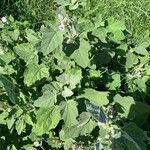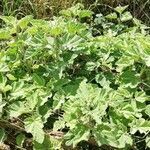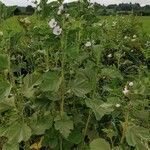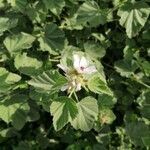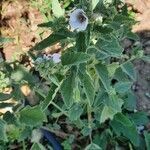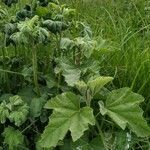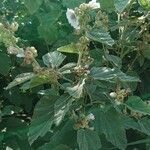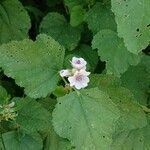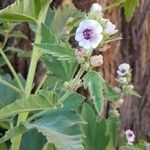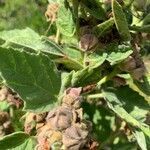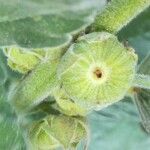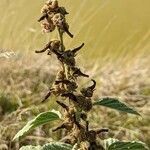Herbs perennial, to 1.5 m. Stems erect, clustered, branched distally or unbranched, softly stellate-tomentose. Leaves: stipules somewhat persistent, usually caducous, linear-lanceolate, subulate, sometimes 2-fid or dentate, (2–)5–8 mm, densely stellate-hairy; petioles 1–6 cm, reduced on distal leaves, usually shorter than blade; blades of proximal leaves ovate or obscurely 3-lobed less than 1/2 to midrib, distal leaves deltate-ovate to ovate, (2–)4–10 × 2–7 cm, base truncate to cuneate, lobes acuminate or broadly acute to obtuse, middle lobe larger than others, deeply plicate, margins irregularly dentate to crenate-serrate, surfaces softly stellate-tomentose, ribs very prominent abaxially. Inflorescences solitary flowers or 2–4-flowered fascicles in leaf axil, sometimes aggregated apically into terminal false racemes. Pedicels/peduncles 0.5–4 cm; involucellar bractlets 8–12, erect, linear-lanceolate, 1/2 length of calyx, 6 mm, lobes 2–6 × 1–2 mm, stellate-tomentose. Flowers: calyx 8–10 mm, lobes narrowly ovate-acuminate, 6 mm, 2 times as long as tube, stellate-velutinous; petals usually pale pink, rarely white, cuneate-obovate, 7.5–15 × 6–13 mm, 2–3 times as long as calyx, apex obtuse or notched; staminal column 3–5 mm, glabrous or sparsely papillose-hairy; anthers in upper 1/2, dark purple; style 15–20-branched. Fruits partially concealed by incurved, somewhat accrescent calyx lobes, 7–9 mm diam.; mericarps 15–20, brown, unwinged, orbiculate-reniform, 1.5–2.5 × 2–3 mm, rugose, lateral surface smooth, membranous, dorsal surface stellate-tomentose with medial furrow. Seeds brown, reniform-round, 1.5–2 × 1–1.5 mm, glabrous. 2n = 42.
More
Herbs perennial, erect, ca. 1 m tall; stem densely stellate hirsute. Petiole 1-4 cm, stellate tomentose; leaf blade ovate-orbicular or cordate, 3-lobed or not lobed, 3-8 × 1.5-6 cm, papery, both surfaces densely stellate tomentose, base nearly cordate or rounded, margin bluntly dentate, apex acute. Epicalyx lobes 9, lanceolate, ca. 4 mm, densely stellate strigose. Calyx cup-shaped, persistent, 5-parted, longer than epicalyx, densely stellate hirsute, lobes lanceolate. Corolla pink, ca. 2.5 cm in diam.; petals ca. 1.5 cm, obovate-oblong. Staminal column ca. 8 mm. Ovary 15-25-loculed. Fruit a disk-shaped schizocarp, ca. 8 mm in diam., enclosed by calyx, puberulent. Seeds reniform. Fl. Jul.
A herb plant which continues to grow year after year. It grows to 1.5 m high and spreads to 1 m across. The root is thick and white and sweet tasting. The stem is thick and woolly and dies down in winter. The leaves are oval and with a short stalk. The leaves can have 3 lobes. The edges of the leaves are irregular and toothed. They are thick and velvety and 8 cm long. The flowers are red, white or purple. The fruit is a hairy nutlet.
Erect, branched, 5–12 dm; lvs ovate, 5–10 cm, coarsely serrate and commonly shallowly 3-lobed, velvety; fls several in peduncled clusters from the upper axils, pink, 3 cm wide; bractlets narrowly lanceolate; 2n=42. Native of Europe; naturalized in salt marshes from Mass. to Va., and locally inland. July–Sept.
